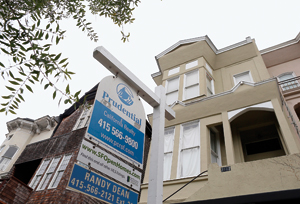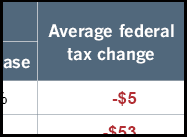CQ WEEKLY – IN FOCUS
Nov. 17, 2012 – 3:07 p.m.
Tweaking the Sacred Mortgage Tax Break
By Shawn Zeller, CQ Staff
Momentum for revising the tax code by reducing rates and cutting back deductions is rising on Capitol Hill. To get where lawmakers want to go, however, they might well have to adjust one of the biggest tax breaks in the code, and one widely viewed as politically untouchable — the deduction for interest payments on home loans.

|
||
|
Not only is the issue fraught, it’s also now front and center. Last year, President
Economists have long complained that the deduction, which reduces the amount of income subject to tax, provides little incentive for homeownership and distorts the real estate market by pushing prices up artificially. Critics of the deduction say it unfairly benefits wealthy homeowners the most, and makes it more expensive for renters to buy houses.
Many economists favor converting the deduction into a credit against taxes owed. Such a change would allow more low-income homebuyers who don’t itemize deductions to take advantage of the benefit. And it would also diminish the value of the deduction for people who purchase more expensive houses.
On converting the deduction, none of the leaders of the House Ways and Means Committee or Senate Finance Committee, both of which oversee tax policy, has endorsed the idea. Some, such as Michigan Rep.
But a coalition of left-leaning groups is trying to show Congress that there is a constituency for an overhaul. And the builders lobby, while defending the deduction, nonetheless concedes some negotiating room. Builders say they’re studying the credit option and say that if it’s generous enough it might help builders who cater to first-time buyers.
“What we learned is that the public thinks the mortgage interest deduction is a wonderful thing and likes it, and eliminating it does not get public support,” says Sheila Crowley, president of the National Low Income Housing Coalition. “But when we talked about modernizing it, people supported that.”
The coalition of left-leaning groups includes the AFL-CIO, Sierra Club and National Council of La Raza. They’re working to build support for both conversion to a credit and a cap on the amount of the benefit.
Public May Be Amenable

|
||
|
Last month, the coalition released a poll in which more than half of the 1,006 adults surveyed said they favored a tax credit over the current deduction. And almost two-thirds said the tax break should be limited to the first $500,000 in home loan debt. The survey found that Republicans, Democrats and independents uniformly liked both changes.
The results follow a Pew Research Center poll last year, which found that 49 percent of Americans favored reducing the deduction compared with 43 percent who preferred no change.
Tweaking the Sacred Mortgage Tax Break
Current law allows homeowners who itemize their taxes to deduct interest on mortgages of up to $1 million for primary and secondary residences, plus on home equity loans up to $100,000. Under the coalition’s proposal, mortgage debt up to $500,000, including second homes and equity loans, would be eligible for the credit. The yearly tax break would be equal to 15 percent to 20 percent of the interest paid.
The credit would be non-refundable, meaning that borrowers who owed less than the amount of the available credit in federal income taxes wouldn’t get a check from the government. The coalition estimates that the change would save the Treasury as much as $40 billion a year — almost half the roughly $100 billion a year estimated in forgone revenue that results from the current deduction.
A Matter of Constituencies
The idea of replacing the deduction with a credit isn’t new.
Obama’s 2010 debt commission, headed by Bill Clinton’s White House Chief of Staff Erskine Bowles and former Wyoming GOP Sen. Alan K. Simpson, proposed replacing the deduction with a 12 percent credit available to all taxpayers on interest paid on up to $500,000 in mortgage debt. Second residences and equity loans wouldn’t have qualified.
About the same time, former Republican Sen. Pete V. Domenici of New Mexico and Alice Rivlin, who headed the White House Office of Management and Budget in the Clinton administration, proposed a credit of 15 percent on up to $25,000 in mortgage interest paid on a principal residence. Domenici and Rivlin included the proposal in a report for the Bipartisan Policy Center, a Washington think tank.
President George W. Bush’s 2005 tax overhaul commission also suggested a credit of 15 percent on mortgage interest, capped by the average regional price of housing.
Some conservative activists are skeptical. The Heritage Foundation’s J.D. Foster, who was an associate director for economic policy at the OMB under Bush, says mortgage interest should remain deductible, because it is taxable income for lenders. Foster says calls to curtail the benefit are “a ruse for tax hikes.”
But others favor the change. Alex Brill, a research fellow at the American Enterprise Institute and chief economist on Ways and Means when California Republican Bill Thomas was chairman in the mid-2000s, earlier this year proposed eliminating the deduction in favor of a 12 percent credit.
The idea of a credit is popular among economists because it would ensure that all homebuyers who take on debt would benefit, not just those who have enough deductions to itemize. About 60 million people would claim the credit, the coalition estimates, compared with 43 million who claim the mortgage interest deduction. More than nine out of 10 new beneficiaries would have household incomes of less than $100,000 a year.
The deduction, by contrast, mostly benefits affluent buyers. According to the Joint Committee on Taxation, homeowners with incomes of more than $100,000 capture about 78 percent of the revenue lost to the deduction. Taxpayers with more expensive houses would pay more under the credit proposal.
The deduction is often defended by the real estate industry as a significant incentive to buy houses. Jerry Howard, chief executive of the National Association of Home Builders, calls it a “driving force to help build homeownership as part of the fabric of American society.”
But many economists dispute that. Andrew Hanson, an economics professor at Marquette University in Milwaukee, for instance, says there’s “absolutely no correlation between ownership rates and the generosity of the mortgage interest deduction.” Ownership rates in developed countries that don’t allow for a mortgage interest tax deduction are comparable to the 65 percent U.S. rate.
Tweaking the Sacred Mortgage Tax Break
Hanson says his research shows that the deduction allows bankers to raise interest rates higher than they could charge absent the tax break. According to Hanson, bankers receive somewhere between 9 percent and 17 percent of the benefit of the deduction.
The Effect on Prices
Many economists say the deduction drives up house prices, since buyers factor the tax benefit into their monthly costs. Higher interest rates and higher prices nullify much of the benefit for first-time buyers.
The deduction also prompts builders to build bigger houses. Another Hanson study found that the square footage of new homes would decline between 11 percent and 18 percent absent the deduction. The reduced energy needs of smaller houses is one reason groups such as the Sierra Club favor a change.
Meanwhile, it’s certain that Congress never intended the deduction as a purchase incentive. When the first income tax code was created in 1894, it included a deduction for all forms of interest payments. Then, and also when Congress enacted a new income tax code in 1913 with the same interest deductibility, few Americans had home mortgages. Cash house purchases were the rule.
Still, the real estate industry, led by the National Association of Realtors, the National Association of Home Builders and the Mortgage Bankers Association, says it will fight any change to the deduction. They have commissioned their own surveys that show the public is with them. The builders released one earlier this year in which almost three in four respondents said they opposed eliminating the deduction and more than six in 10 said they would be against any reduction in it.
The lobbying groups say any change to the deduction would set back the recovery. But at least one group, the builders, says it is looking carefully at the credit option. Howard concedes that a credit that would shift tax benefits to lower-income and first-time buyers might benefit many of his members. But the design of such a switch would be crucial, he says. His group’s preference, of course, would be for a very generous credit, and one that would require the Treasury to cut checks to lower-income taxpayers with little tax liability.
“We’re not prepared to say it would work,” he says. But, “because people are talking about it, we feel an obligation to understand it.”
FOR FURTHER READING: The elements of tax “reform,” CQ Weekly, p. 2085; housing and the economy, 2010 CQ Weekly, p. 544; making the tax code economically neutral, 2005 CQ Weekly, p. 288; 1986 tax overhaul (PL 99-514), 1986 Almanac, p. 491.